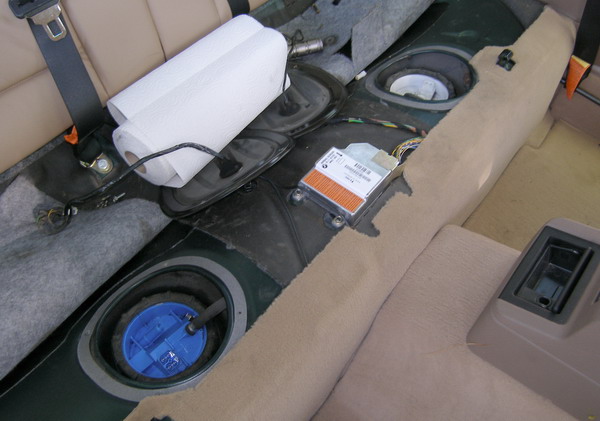April 29, 2006
 Fuel Pump and Sender Replacement
Fuel Pump and Sender Replacement
The 3-series fuel tank straddles the hump in the floor that provides clearance for the driveshaft. For this reason, the tank has a sender / suction unit to pull fuel from the driver's side (white unit) and a pump / secondary sender unit located on the passenger's side (blue unit). I decided to replace these units now for several reasons:
- I'd heard of various issues with the senders on some of the earlier vintages of the 328. In all cases the cars were of fairly high mileage (> 100K miles). Mine just passed 126K.
- I'd heard that this job could get a bit messy, so given my planned interior refurbishment I figured I'd replace the units now and avoid spraying fuel on my new carpet and leather later.
- I considered this good preventative maintenance. Failure of the fuel pump stops the car dead in its tracks -- something I'd rather avoid given all the late night driving I do out in the sticks.
- I figured this would be an easy first project in my quest to do as much of my own maintenance as possible to reduce costs (after all, I have two BMWs to maintain now!) and simply learn more about my vehicles (knowledge is power!)
Over the years I've owned the BMW I have never really been as motivated about working on it myself as I have my other cars. Not exactly sure why, but I suppose it's a combination of the great service I've received from my dealer's maintenance department and the nature of the beast -- some maintenance procedures involve a $17000 BMW diagnostic computer that I have no intention of buying.
Fortunately, replacing the fuel pump / sender units is one of those tasks that does not involve the diagnostic computer. In addition, it can easily be performed by an owner with modest mechanical / technical ability and common hand tools. A combination of great online DIY articles and reassurance from my technician convinced me I could do this myself and save around $250 in labor in the process, so that's what I did.
The parts required for the task involved the pump ($160), sensor unit ($45) and two gaskets ($5 ea), or a total of $212 with tax. While I was at it, I also picked up a bottle of BMW Gasoline Treatment (Techron) on a separate trip, but the parts guy was kind enough to throw that over the wall for free rather than write an invoice for $2. I've said this before, but it's actually cheaper to buy Techron from a BMW parts department than in the retail space because it was developed by Chevron for BMW. It works for all cars, so if you're looking to clean up the injectors and top-end of your engine (probably a good idea at every inspection interval or 18K miles), drop by your local dealer for a bottle.
In any case, I completed the job in about 2 hours. I let the engine idle for a few minutes to make sure I had good fuel pressure and put my ear to the pump to make sure it was running properly before I buttoned everything up and took a "spirited" test drive around the block. Once that was out of the way, I grabbed the bottle of engine treatment and headed for my local gas station to top off with 93 octane (at no less than $3.07 a gallon...errrr). When I turned the key to start the engine for the short drive home, the fuel gauge rose to the proper place (just beyond the "F" indication), which indicated that the senders were working as expected. Mission accomplished.
I found the online DIY articles lacking a few details that I thought would help a newbie such as myself, so I plan to write my own. Look for it soon here. And speaking of BMW DIY articles, check out this great link aggregation site bimmerdiy.com.
Parts: $212, Labor $0, Labor Savings: $350, Mileage: 126096



